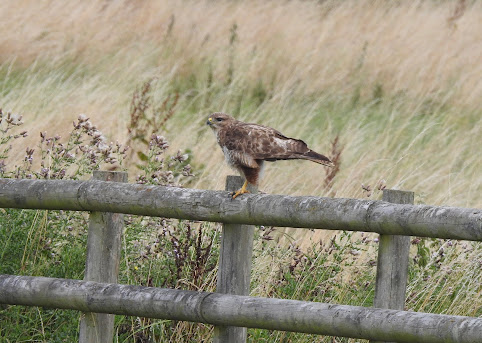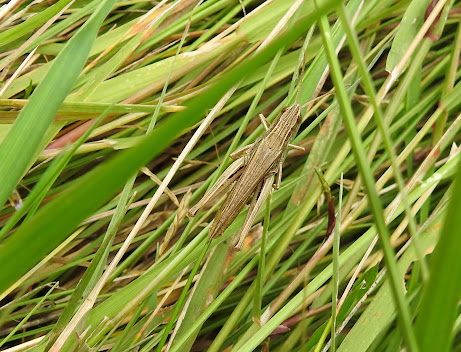I need to start this post with yesterday's events. The afternoon was largely sunny, not too hot with a light westerly breeze. Ideal for Lyn and I to lounge in the garden. After a short burst of the inevitable dead-heading Lyn settled down to read a book, while I found my eyes drawn skywards as usual.
You may recall that at the end of July I mentioned having seen a few Swifts over the garden, and was reckless enough to suggest that these might be the last of the year. Since then I had seen several more, but I was still pleased to count half a dozen shortly after we settled. Then some more, and more. I thought I'd better start counting. At this point I was still willing to accept these could be the same group circling, but when the next party totalled 93 I realised I was actually watching a true movement.
 |
| This image captures just a handful of Swifts |
By the time we went in, about two hours later, I had logged 347 Swifts, a Hobby, and a couple of House Martins all drifting west into the breeze. They were all high up, and a casual glance would have missed them, but this was miles more Swifts than I have ever seen from the garden. We were also treated to the spectacle of about 80 Gulls, mostly Black-headed Gulls, with smaller numbers of Lesser Black-backed Gulls, and Herring Gulls presumably on ant patrol, although there was no evidence of our flying ants taking to the wing.
So that brings me to this morning. I arrived at Morton Bagot in time to photograph a Common Buzzard from the car, pressing the shutter just before it took flight.
 |
| Buzzard |
It's a good time of the year for seeing lots of birds, but you have to time it right. I didn't. A flock of about 60 passerines, mostly Blue Tits with other tits and several warblers was heading down a hedge and away. Ideally you need to be in position as they arrive, and not be left with glimpses of tails as they depart. My best sighting at the end of the access road was a Reed Warbler, again all too brief.
By about mid-morning I was ambling towards where the ringers generally set their nets, when a rumbling noise turned out to be a huge tractor. I stepped aside, but it halted and turned to contain Phoebe who I had met at the Bioblitz event organised by HOEF. She said hi and apologised for the fact she was due to resume the mowing of the weedy field, which could disrupt my morning. Naturally I said this was fine, and I would keep out of her way.
The field was indeed mown flat, with a substantial swathe in the middle (where the Red-backed Shrike had been), left uncut. I followed my usual route, the flash field containing roughly the same birds as at the weekend, minus the Shovelers. Phoebe had kindly explained that the job she was doing was part of the HOEF's conservation plan and would be beneficial to wildlife in the long run. This I accept, but I couldn't help but feel very sorry for all the bugs which had been in the wrong field at the wrong time.
As I reached the sunny bank near Stapenhill Wood, I found that the long grass which had been spared by the mower was alive with crickets and grasshoppers. These had presumably been the lucky ones which been able to hop or crawl to safety. It was quite captivating and I abandoned the birds in order to see what I could find. I'm no expert, but reckon there were Field Grasshoppers, Meadow Grasshoppers, Lesser Marsh Grasshopper (just one if I've identified it correctly), Long-winged Coneheads, Dark Bush-crickets, and Roesel's Bush-crickets. Photographing them was tricky.
 |
| Field Grasshopper |
 |
| Roesel's Bush-cricket |
 |
| Lesser Marsh Grasshopper |
 |
| Long-winged Conehead - look at the length of those antennae |
No comments:
Post a Comment